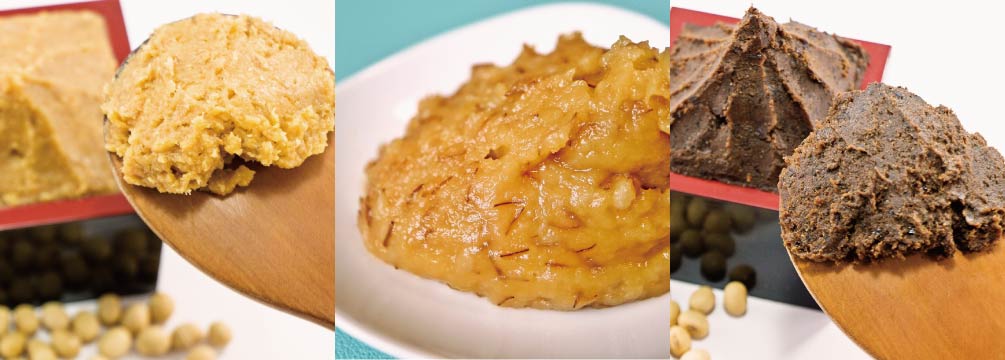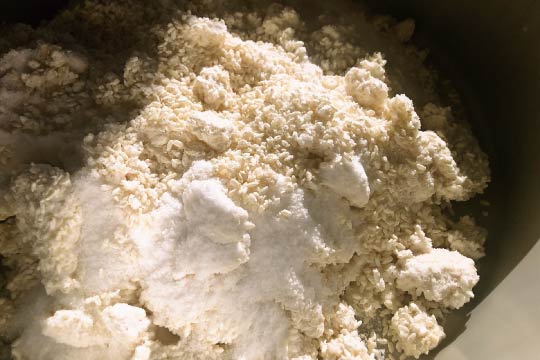News & Blogs
Evaluation of miso: exclusive medication for noblemen turned into everyday Japanese food.
All miso is not made equal. Raw materials determine the flavor profile.
Pleasant surprise! Koji promotes youthful skin.
In this blog, we touch on diverse topics about Japanese food cultures, practices together with the culinary secret, TREHA®, and its important role in the Japanese food industry. We hope our blog helps you obtain in-depth knowledge of the secrets and science behind Japanese cuisine, shared from our kitchen, to yours.
Click for 'Koji is a beloved Japanese national fungus with a history of 1300 years: 1 of 2.'
Koji-kin, “Aspergillus oryzae,” is the essential ingredient for miso, soy sauce, and sake. Today, I would like to showcase Miso, one of the famous Koji products and an iconic Japanese superfood.
Emerged as precious medication for noblemen, Miso had a long journey to be a Japanese staple in three distinctive types: rice miso, barley miso, and bean miso. Add a small amount of Miso to accentuate your dishes. Yes, for both savory and sweet dishes. For example, Miso should work with your salted caramel ice cream.
Miso evolved from a luxurious item to samurai's portable food and everyday Japanese food.
The origin of the word “Miso” is rooted in “Sho (or Hishio)," introduced from China. Sho (or Hishio 醤) is the ancient Chinese fermented seasoning made of meat, fish, salt, and Koji. Rather than fully fermented Sho, the Japanese liked the taste of premature Sho pronounced as “Mi Sho 未醤,” meaning “Sho-to-be,” which is speculated to become “Miso.” The description of “Mi Sho” is recorded in the Taihō Code (大宝律令, Taihō-ritsuryō), the first Japanese law book published in 701.
According to the HIKARI MISO's web page, Miso has been seamlessly handed down in Japan to this day. Soon after introduction, Miso was precocious food consumed only by temples and noblemen as a main dish or medication instead of soup.
Later, miso soup became prevalent when the samurai established the ideal eating habit, including a bowl of soup. Then, home brewing of Miso became common among the wealthy, followed by the age of mass production. Below is the evolution of Miso.
Miso as monthly salary of high-ranking bureaucrats in the Heian period (794-1185):
Miso was a luxury item beyond the reach of the commoners and was used as a sprinkle, seasoning, or medication.
Miso 󠄀soup was born in the Kamakura period (1185-1333):
Chinese monks introduced mortars and pestles to process coarse miso paste into the fine paste, which became more water-soluble, making it suitable for soup making. The silky miso paste became part of an ideal simple meal concept of “Ichiju Issai 一汁一菜,” meaning one bowl of soup and one side dish, was established among samurai.
Homemade Miso emerged in the Muromachi period (1336-1573):
As soybean cultivation increased, the Japanese started to make for their Miso at home. Commoners began to consume miso soup, and many miso dishes developed in this period, which still exist today.
Miso was one of the essential military supplies in the Sengoku period (1493-1590):
Soldiers during the warring states carried rice and Miso as military food. Lord Shingen Takeda encouraged the miso-making in preparation for the expedition, and Lord Masamune Date built Japan’s first miso 󠄀factory. As a result of the provisions strategy, former territories of the famous warlords are known for miso production.
"Spend your money for a miso shop rather than a doctor" in the Edo period (1603-1868):
Miso became an indispensable food as it is today. The population of the Tokyo area (Edo) has reached 500,000. Since the local miso production was not enough to feed the growing population, Miso produced in other regions were brought in, making Tokyo’s miso distributors prosperous. As the first recipe book about Miso was published, miso 󠄀dishes were prepared throughout the country.

Types of Miso and how to use them.
For over 1300 years, Miso, nurtured by the Japanese, developed into an iconic national food item. Miso is produced in many parts of Japan with flavor profiles that vary by raw materials, climate, and local preference. There are roughly four types of Miso. The following are the characteristics of flavor profiles and raw materials for each type.
Rice miso (Kome miso 米味噌): Made from rice, soybeans, and salt in addition to Koji. Shiro miso (white miso) belongs to rice miso. Rice miso gets along with any dish due to its mild and well-round flavor. According to the Marukome Company, a large miso manufacturer, 80% of the Miso used in Japan is this type.
Barley miso (Mugi miso 麦味噌): Made from only soybeans and salt with Koji propagated on cooked barley berries (or sometimes wheat) instead of cooked rice. Barley miso has two noticeable differences from rice miso: aroma and richness in taste. The smell is similar to the appealing waft of freshly baked bread, which intensifies with the length of the fermentation period. In general, barley miso is not as sweet, savory, or rich as rice miso. It is primarily produced in warm areas such as the Chugoku, Shikoku, and Kyushu regions, where miso soup is not consumed to get warm. In contrast, cold miso soup is a local delicacy to survive the summer heat in the Kyushu area.
Bean miso (Mame miso 豆味噌): Made from only soybeans and salt with Koji propagated on cooked soybeans instead of cooked rice. Bean miso is mainly produced in the Chukyo regions, with the fermentation period between 1-3 years resulting in a dark reddish color. It features a bold and complex flavor packed with umami. Astringency and acidity are more prominent than rice or barley miso.
Mixed miso: Made with blending 2 or 3 types of miso above, aiming to capture the goodness of each type.

The miso soup you would have at Japanese restaurants in the US is likely using rice miso. Although it might be rare to come across barley miso or bean miso, I suggest trying to taste them when you have a chance. You will be surprised to discover all Miso is not made equal.
Rice miso with a shade between white and golden brown is a versatile seasoning for various dishes such as grilled or stewed protein and vegetables. Thus, when you wonder which type of Miso to choose from, rice miso is the first choice. Since rice miso with white shade (Shiro miso) does not change the color of the dish, it can be added to white-colored dishes like gratin and cream pasta as your secret flavor enhancer.
Barley miso has been confirmed to go well with pork. In addition, the subdued sweetness of barley miso complements the natural sweetness of vegetables. Thus, it is often used in sauces and dips. Barley miso paste may contain fibrous black parts of barley, which are removed to reduce the gritty texture.
The rich and bold flavor of soybean miso is often used to add some kicks to simple ingredients. It also becomes a powerful flavor enhancer to accentuate stews, stir-fried dishes, sauces, and dips.
Besides savory items, Miso can act as a pinch of salt to create a pleasing contrast in sweets, including caramels, chocolate desserts, and baked goods. The nice bonus is enhanced umami and depth. Please refer to King Arthur's article, “A Beginner’s guide to baking with Miso.”

Let's go back to Koji. Did you know that Koji promotes youthful skin?
Going back to Koji, there is an interesting side story about Koji, the Japanese love of over a millennium. Koji is also the raw material for a cosmetic ingredient called Kojic acid, which has been confirmed to inhibit the production of tyrosine, followed by melanin production, a cause of aging spots. Kojic acid has been formulated in a wide variety of skincare products. I am fully convinced of the purpose because I witnessed that people in sake brewing have spotless and youthful skin. I visited many sake breweries and gained opportunities to talk to brew-masters even before I learned about Kojic acid. All of them had glowing, youthful skin, especially on their hands. Their hard-working hands were spotless and healthy-looking without wrinkles, yes, including the hands of an 80-year-old lady. When I saw her, I had to stop my urge to ask if they needed a short-term internship. Also, Mr. Okada of Marukura, who I introduced in the previous post, had noticeably youthful skin (and hair.) I conclude that consuming and touching Koji for an extended period is good for us.
While I was extensively researching Koji on the internet, I found some chefs who fell in love with Koji, producing Koji by themselves or experimenting with Koji on various items I could never think of. This made me remember my grandmother, “amazake-sensei,” and my aunt, “killer miso expert.” I am delighted to see Koji flying high beyond Japan. I have a personal belief in Koji healing the world by making the ordinary taste into the extraordinary while providing health benefits.

Koji might not always stand in the center stage of the culinary world, but it does magic behind the scene though bringing out the goodness of the food. I hope the more you know, the more you will be fascinated by Koji.
Did you find this blog interesting?
Please share it with your friends in the food service industry.
We regularly update the blog about the food culture of Japan, where TREHA® was discovered for culinary applications.
Click here and send us a message to subscribe.
Or hit us up on Instagram @trehalose_sensei!
You might also be interested in:

